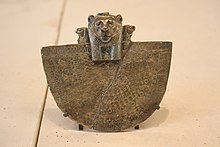Neck Collar (Ancient Egypt)
| Aegis in hieroglyphics | |||||
|---|---|---|---|---|---|
wesech / usech wsḫ Wesech , wide neck collar |
|||||

The neck collar is a typical ancient Egyptian necklace. It is usually a wide collar, which consists of several strings of pearls and at the ends of which there can be various symbols. These mostly include falcon heads, vultures with outspread wings and falcons or uraeus snakes .
development
The collar was initially an ornament with which the king rewarded his officials and the landlord his subordinates. Since the Middle Kingdom , the neck collars were part of the equipment for the dead and were depicted on device friezes of coffins. Collars with falcon heads were found on mummy-shaped coffins until the late period . Since the late period there has been a separate saying in the Book of the Dead: "Neck collar of gold that is placed on the neck of the transfigured on the day of burial" (Proverbs 158).
In later figures, the goddess Bastet held the neck collar as a shield in front of her chest, and the cats of Bastet also wore the aegis as a neck cord. The (erroneous) name Aegis was probably derived from these Bastet figures , because the term was originally used to describe the shield of the Greek gods Zeus and Athene .
meaning
The neck collar served primarily as a protective symbol and was also often recited in sayings for the ritual of opening the mouth and when dressing the image of the gods . In the Abydos temple of Seti I, there is a representation in the chamber of Re-Harachte in which the king offers a collar with a breast plate as clothing for an image of a god. This ritual was probably part of the morning service. The collar may also be reminiscent of the god Atum , who spread his arms around Schu and Tefnut to convey his ka to them. Turning the collar on was thus equivalent to being embraced by divine arms. It thus had the same meaning as the vulture with outspread wings on the sarcophagus of Thutmose I.
Other forms
Furthermore, from the New Kingdom onwards there were collars as amulets (called modern with the Greek term aegis ), which carry the head of a god, a holy animal or the king, with female deities predominating in this form. Occasionally a pair of gods was also shown, e.g. B. Onuris and Tefnut united. The collars were not only found on mummies, but also as chain links or trimmings on finger rings and earrings. In addition, there were small replicas as amulets for the dead.
Originally there were gods 'heads above breast collars on gods staffs , as well as front and rear stems of gods' barges . The aegis was actually just an image of a god and the collar was just an addition. In the case of consecrated deities, the collar was occasionally given a menit handle and possibly even served as a cult instrument.
literature
- Hans Bonnet : Real Lexicon of Egyptian Religious History. Photomechanical reprint of the 1st edition 1952. 3rd unchanged edition, de Gruyter, Berlin et al. 2000, ISBN 3-11-016884-7 , pp. 8–9, → Aegis .
- Manfred Lurker : Lexicon of the gods and symbols of the ancient Egyptians. New edition. 3. Edition. Fischer Taschenbuch Verlag, Frankfurt am Main 2008, ISBN 978-3-596-16693-0 , pp. 38-39, → Aegis .
Web links
Individual evidence
- ↑ Ludwig Borchardt : The grave monument of King Sáḥu-re '. Volume 2: The Murals. (= Excavations of the German Orient Society in Abusir 1902-1908. Vol. 7; Scientific publication of the German Orient Society. Vol. 26). Hinrichs, Leipzig 1913, p. 67.
- ↑ a b H. Bonnet: Reallexikon der Ägyptischen Religionsgeschichte. Berlin et al. 2000, pp. 8–9, → Aegis .
- ↑ Alexandre Moret : Le rituel du culte divin journalier en Égypte, d'après les papyrus de Berlin et les textes du temple de Séti 1er, à Abydos (= Annales du Musée Guimet. Bibliothèque d'études. Vol. 14). Leroux, Paris 1902, p. 242.
- ^ Ernesto Schiaparelli : Il libro dei funerali degli antichi Egiziani. Volume II, Loescher, Rome a. a. 1890, p. 37.
- ↑ M. Lurker: Lexicon of the gods and symbols. Frankfurt am Main 2008, pp. 38–39, → Aegis .
- ^ EA Wallis Budge: The mummy. Causeway Books, New York 1974, ISBN 978-0-88356-026-6 , plate 23.
- ^ F. Bisson de la Roque: Rapport sur les fouilles d'Abou-Roasch (= Fouilles de l'Institut français d'archéologie orientale du Caire. Vol. 1, part 3 .; Fouilles de l'Institut français d'archéologie orientale du Caire. Vol. 2, Part 1). Imprimerie de l'Institut français d'archéologie orientale, Le Caire 1922/23, plates 7 and 13.
- ↑ Heinrich Schäfer : Egyptian goldsmiths work (= messages from the Egyptian collection. Vol. 1). Curtius, Berlin 1910, plate 9, 22/3, p. 112/3.
- ^ H. Schäfer: Egyptian goldsmith work. Berlin 1910, plate 17 no.122.
- ↑ Jean Capart : Une liste d'amulettes. In the magazine for Egyptian language and antiquity. (ZÄS) No. 45, 1908–1909, pp. 14–21 full text online .
